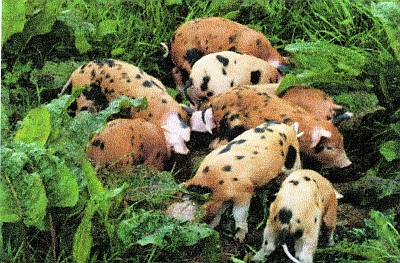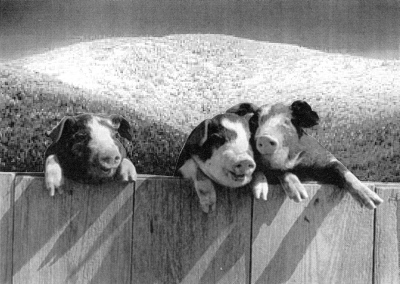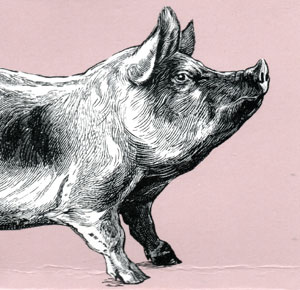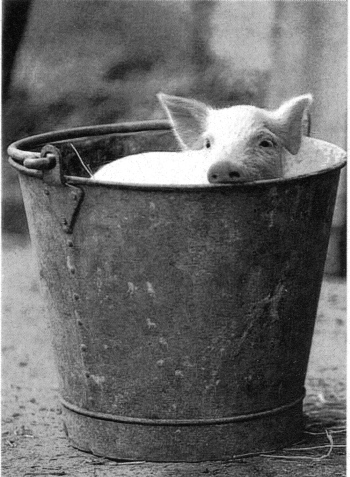Our Education Correspondent chronicles the return of the heritage pig.
The Oxford Sandy and Black (OSB), also called the ‘Plum Pudding’ or ‘Oxford Forest’ pig, is a traditional farmers' and cottagers' breed. These pigs made their first appearance in the forests around the Cornbury estate in West Oxfordshire over two centuries ago and are among the oldest extant British breeds. Virtually extinct twenty years ago, OSB pigs are increasing in popularity now.

Peter and Pat Colson have owned a farm in the West Oxfordshire village of North Leigh since 2003. They raise sheep, cattle and Welsh ponies, operate a livery yard and also breed OSBs. Both of the Colsons come from farming families, and Peter has been breeding pigs for 50 years. He follows family tradition; when his grandfather retired from his farm on the Cornbury estate during the 1950s, he had been the last commercial OSB breeder. When Peter took over the farm only two or three other breeders remained, and his probably was the largest mob.
The appearance of the breed is sandy with black blotches (not spots), along with white blaze, feet and tassel. The ears should be lop or semi lop (floppy); 'prick' ears are not considered desirable. OSBs are smaller than most pigs in both height and length. OSBs are renowned for their propensity to root below forested undergrowth and their appearance also reflects that trait. Ideally they have big rear ends, small loins and small fronts to facilitate foraging down into the roots.
The breed is divided into four male and thirteen female bloodlines. The lines of boar are Alexander, Alistair, Clarence and Jack. The sows; Alison, Clare, Clarissa, Cynthia, Dandy, Duchess, Elsie, Gertrude, Gloria, Iris, Lady, Mary & Sybil. The Gloria line is rarest of all, numbering only seven pigs. The Colsons breed from the Alexander, Clarence, Clare and Duchess lines. OSBs are classified as ‘rare’ by the Rare Breeds Survival Trust because only some 300 breeding sows exist in Britain. For comparison Gloucester Old Spots, perhaps the best known rare breed, include over a thousand sows.

OSB litters usually are small, on average 8-10 piglets, though they can get as numerous as 17, a number of piglets too high for the sow to support. An individual OSB is no more expensive to raise than other breeds, but their smaller litters lower the return on investment. A commercial white pig could have 30 to 40 piglets per year whereas an OSB sow is unlikely to have more than 20.
The OSB is a friendly, well mannered and hardy pig with good mothering abilities. The piglets on the Colson farm are naturally weaned by their mothers, and stay in family groups. Their diet is completely natural and free from hormones, growth promoters and antibiotics. Rare breeds like the OSB and especially the Gloucester Old Spot are inclined to run to fat, so breeders feed them minimal protein; the Colsons feed their pigs on leftover fruit and vegetables from the garden, including apples and beans. Because they are easy to look after, OSBs are an ideal choice for the novice breeder.
OSBs should be butchered at 6 months; older pigs carry too much fat and the males can have the taint of boar if they are covering sows. Anyone who has tasted heritage pork will understand why breeds like the OSB have resurfaced. Its succulent meat compares favorably with the esteemed Tamworth, a slightly more numerous rare breed with over 400 sows. The heritage breeds produce succulent pork, fine bacon and excellent ham and sausages. The whole pig, including the cheeks and ears, make good eating and suitably crisp crackling is almost guaranteed by its relatively high fat content.

Years ago, when lighter (and blander) meat became fashionable, traditional breeds with their dark, rich meat became scarce as farmers produced what supermarkets wanted. Only the dedication of enthusiasts like the Coulsons saved the OSB from extinction. Now the trend has turned, so that both specialist butchers and restaurateurs encourage farmers to breed traditional pigs.
Local butchers have asked the Colsons to fatten their pigs for market but feed is so expensive that the option not commercially viable for them. The Colsons therefore sell most of their pigs to other farmers as weaners at eight weeks. If, however, they keep a pig longer to sell for breeding they can get twice the price for both sows and boars. Commercial sows live for three to four years before they are butchered for bacon, but the Colson’s sows survive much longer, for eight or nine years. The meat of the old sows goes into sausages.
There is a thriving niche market for this rare breed and the Colsons do not have enough piglets to supply the demand for them. They do not sell to supermarkets but some buyers come from as far away as Sussex, and two local restaurants in Oxford along with another pair in London serve Colson pork fattened by other farmers.
Peter Colson is Chairman of the Oxford Sandy and Black Pig Society.
Some notes on British heritage breeds.
The only pig that comes close to the Oxford Sandy & Black in flavour is the Tamworth but they are not as good-natured and therefore harder to control.
Heritage breeds of pig are particularly susceptible to changes in the economic climate, and the population of individual breeds therefore can fluctuate dramatically. The fluctuating cost of feed and the price of breeding, or ‘finished,’ stock are of course the main factors affecting the economic viability of raising pigs for market. Diseases that require culling, such as Foot and Mouth Diseaese, also threaten the continued existence of the British heritage breeds.

The Position Now
The Rare Breeds Survival Trust classifies the status of each British rare breed according to the estimated number of breeding sows and its population trend. The British Pig Society keeps records of the number of registered females as well as of 'breeding sows.' The data presented dates from 2007.
Rare breeds: The current Position according to the Rare Breed Survival Trust classification system.
Endangered (less than 200 breeding sows)
- British Lop (150-200 females)
- Middle White (398 females)
Vulnerable (less than 300 breeding sows)
- Berkshire (656 females)
- Tamworth (466 females)
- Oxford Sandy & Black (373 females)
- Large Black (366 females)
- Welsh (353 females)
At Risk (less than 500 breeding sows)
-British Saddleback (864 females)
Minority (more than a 1,000 breeding sows)
- Gloucester Old Spots (1328 females)
- Large White (971 females)
Extinct British pig breeds include the Cumberland, Lincolnshire Curly Coated, Ulster White, Dorset Gold Tip and Yorkshire Blue.
Some rare breeds and some of their characteristics.
Middle White is a chunky white pig with a dished, or 'squashed-up,' face and prick ears. It is believed that the Emperor of Japan will eat no other kind of pork.
The Berkshire pig is a medium-small animal, black with white points (feet, snout and tip of tail), and prick ears.
The Tamworth breed, which logically enough originated near Tamworth is descended from the Old English Forest Pig. It is red or ginger coloured and its long snout is typical of older British stock.
The Large Black was developed from the black pigs of Devon and Cornwall, and pigs found in East Anglia. It is a docile, lop-eared pig, whose skin colour makes it tolerant of many sun-borne illnesses. Its hardiness and grazing skill make it an efficient meat producer.
Welsh pigs are a droop or lop-eared white breed with slightly dished faces. The lop ears meet at the tips just short of the pig's nose. They have shorter legs than most other breeds, but have very long bodies, especially considering the length of leg. They also are quite muscular and lean.
British Saddleback is a hybrid of the Essex and Wessex Saddleback, two breeds which shared a similar colour pattern but differed in other characteristics. It is a large lop-eared pig with a white band across the saddle, around the legs and shoulders and may have a white tail tip and hind feet.
The Gloucester Old Spot is one of the largest pigs raised in Britain. They originated in the Berkeley Vale area, where it was known as the Orchard Pig where it was reared on windfall apples and whey, a byproduct of local agriculture. Originally a only a localized breed, the Old Spot recently has become popular. Hardly a restaurant or butcher in the south Midlands and Southwest does not have 'Gloucester Old Spot' for sale at least some of the time.
Mangalitza/Lincolnshire Curly Coated. Although the Lincolnshire Curly Coated breed died out in Britain in 1972, the breed had been exported to Austria and Hungary early in the twentieth century because it was a successful and hardy stock capable of withstanding their harsh winters. The Hungarians crossed the Lincoln with their 'Mangalitza,' a similar curly-coated pig.
There are now more than 48 'Mangalitzas' in Britain. Recent births have attracted considerable media interest, usually under the rubric of "Is it a sheep or a pig?"
The Lincolnshire Curly Coated was the only British pig that had to be sheared and whose hair was woven or knitted into attractive men's sweaters.

